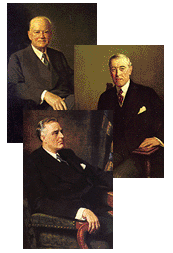|
|
|
 |
|
|
History
of German-American Relations > |
|
World
War I On August 4, 1914, President Woodrow Wilson proclaimed U.S. neutrality in the European war. This changed abruptly on May 7, 1915, when a German submarine sank the British ocean liner Lusitania with 1,198 people aboard, among them over 100 Americans. When Germany announced on January 31, 1917 a policy of unrestricted submarine warfare, the United States cut diplomatic ties with Germany. After the sinking of five U.S. vessels, Wilson formally declared war on April 6, 1917. The war affected the lives of German-Americans in unique ways. German-language instruction ended in most states; hundreds of German-language publications ceased to exist. German music was no longer played and many streets, buildings, and even cities were renamed. Sauerkraut became "liberty cabbage" and hamburgers turned into "Salisbury steaks." President Wilson presented his Fourteen Points in January 1918 as the basis for a just peace. It called for the abandonment of secret international agreements, a guarantee of freedom of the seas, the removal of tariff barriers between nations, reductions in national armaments, an adjustment of colonial claims with due regard to the interests of the inhabitants affected, self-rule and unhampered economic development for European nationalities. The Fourteenth Point called for the formation of an association of nations. When the armies of Germany were beaten back in the fall of 1918, the German government appealed to Wilson to negotiate on the basis of the Fourteen Points. The president conferred with the Allies, who acceded to the German proposal, but only with some compromises. An armistice was concluded on November 11, 1918. Weimar
Germany In 1928 Herbert Hoover, the first president of German ancestry, was elected. The
stock market crash of 1929 marked the end of an era of prosperity and
led to the worst depression in American history. The German economy
also faltered. Germany faced severe economic hardships, high unemployment,
and runaway inflation. The days of the Weimar Republic were coming to
an end.
A new wave of emigration from Germany to the United States occurred.
These refugees from Nazi Germany included Albert Einstein, Thomas Mann,
Kurt Weill and Marlene Dietrich, and other artists, scientists, musicians,
and scholars. With the exception of the German-American Bund, with Fritz
Kuhn as its "Führer," there was little Nazi support in
the United States. Most German-Americans were loyal to the United States
and indifferent to the appeal of international Nazism. |
||
|
Texts
are abridged from U.S. State Department IIP
publications and other U.S. government materials. |
||
| What
kind of information materials are available?
CD: These documents are available in fulltext format on the About the USA CD-ROM. Teachers: Request a copy for classroom use. L: Selected documents are available in German as well as other languages, including Arabic, Chinese, French, Spanish, Persian and Turkish. |
DISCLAIMER
Any reference obtained from this server to a specific commercial product, process, or service does not constitute or imply an endorsement by the United States Government of the product, process, or service, or its producer or provider. The views and opinions expressed in any referenced document do not necessarily state or reflect those of the United States Government. |

